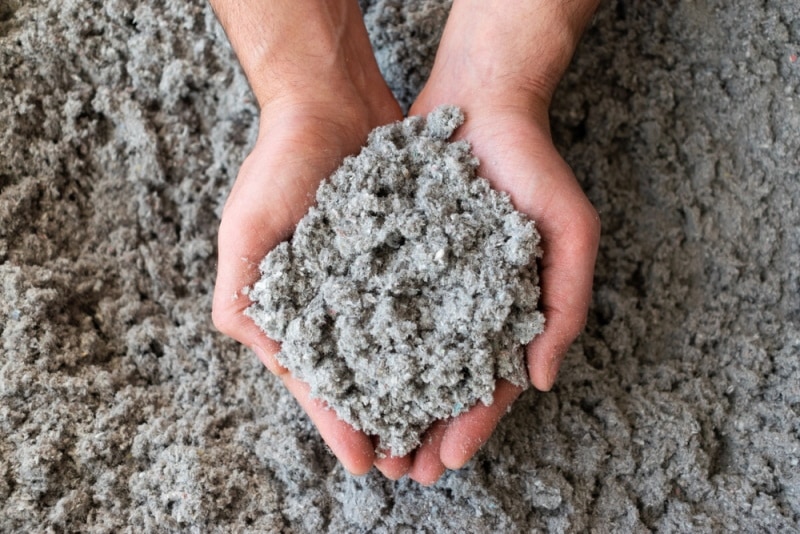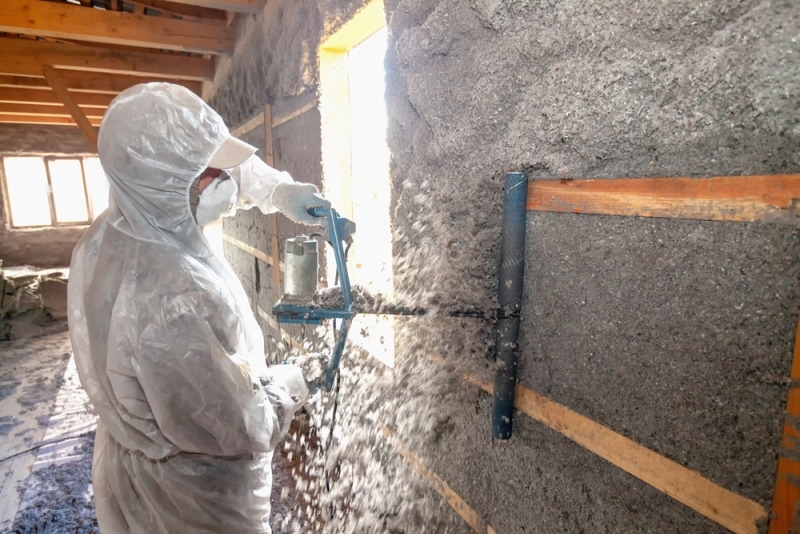What is Cellulose Insulation, and Where is it Used?
-
Codee Chessher
- Last updated:

Insulating your home will keep it warm in the winter and cool in the summer, and comfortable the rest of the time. Cellulose insulation is the oldest form of insulation, used to fill attics and other enclosed spaces in homes everywhere. It can be hard to know exactly how cellulose works and when to use it, but it’s not as complicated as you’d think.
Let’s dive in below with a comprehensive look at cellulose insulation, including its pros and cons.

What is Cellulose Insulation and How Does it Work?
Cellulose is a tough fibrous material found in trees, plants, cardboard, wood, paper, and more. When you shred fibrous materials like these, you get loose cellulose. Cellulose can be used to fill enclosed spaces like attics and crawl spaces, but different areas require different types of cellulose—we’ll get into those a bit later.
Cellulose is used as insulation because it’s plentiful, cheap, and packs tighter than fiberglass insulation. The insulation can be blown into attics and other inaccessible spaces with a special blower machine or packed densely in more accessible areas. Most cellulose insulation is made from recycled newspaper or other paper and cardboard products, making it more eco-friendly than fiberglass or foam insulation. Cellulose also doesn’t require greenhouse gasses as a propellant, which makes it among the most eco-friendly insulators you can use.
Cellulose is less vulnerable to wind washing than fiberglass. Wind washing is a phenomenon where air seeps into insulated spaces and deposits dirt and dust behind. Dirty, dusty cellulose has very poor insulating properties, so this is a major pro in windy climates.

You’re probably thinking that a ton of shredded paper fiber in your walls sounds like a tinderbox. You’d be right, which is why cellulose wasn’t used as insulation very much until after the 1950s or so. Around that time, fire codes were updated to mandate fire retardants in flammable insulation. This fire-retardant treatment washes off if the insulation gets wet, so be extremely careful.
The R-value of cellulose insulation is 3.2–2.8 per square inch, which is significantly higher than fiberglass insulation’s R-value of 2.2–2.7. The higher the R-value, the better the insulation is at preserving thermal efficiency—AKA keeping your home’s temperature stable.
Cellulose is also a great soundproofing material on par with fiberglass. You can use it to supplement rooms where you practice musical instruments or to soundproof a workshop or movie theater room.
Notably, cellulose insulation doesn’t require a separate vapor barrier, but a vapor barrier may be required depending on your local climate and building codes. For moist and cold areas, you definitely need a vapor barrier to prevent moisture from collecting in the insulation. Cellulose dries very slowly once it gets wet, so you want to avoid it from happening in the first place.
Consult an insulation expert
Find an insulation specialist in your area, and get free, no-commitment estimates for your project.

What Are the Different Types of Cellulose Insulation?
There are two main types of cellulose insulation: loose-fill and densely packed. Loose-fill cellulose is typically used to insulate attic cavities and other hard-to-access areas. Technicians will run a hose through your home and fill the area with loose insulation.
Dense-packed cellulose is a bit different, insulating a bit better but requiring more work. Technicians have to actually get in there and pack the insulation, but that’s the best insulation for small, enclosed spaces. Dense-packed cellulose insulation can also be used to enhance a room’s soundproofing—it’s great if anyone in the house plays music. Lastly, dense-packed insulation is a better choice for insulating new walls before you seal them up.

Where Is Cellulose Insulation Used?
Cellulose insulation can be used nearly anywhere you need insulation, but it’s typically used to fill attics, walls, floors, crawl spaces, and other empty areas within the structure. Loose-fill cellulose is best used to fill large spaces, and dense-packed insulation is used to fill smaller cavities.
Advantages of Cellulose Insulation
When choosing insulation, you want to know what makes each type special and worth using in your home. The good news is that cellulose has numerous benefits that make it useful for insulating your next home project or expansion. Let’s check some of these benefits out below.
- High thermal efficiency
- Can save you money on electricity
- Made almost entirely out of recycled material
- Cheap
- Widely available
- Relatively easy to install
- Less susceptible to wind washing than fiberglass

Disadvantages of Cellulose Insulation
Like anything, cellulose insulation isn’t perfect. There are some things you should be aware of that might make you decide against using cellulose in your next home project. Follow along below to find out why.
- Can settle and leave wide gaps in walls, especially with insulation installed pre-1970s
- Must be kept dry
- Loses fire treatment after getting wet
- Messy
Frequently Asked Questions (FAQs) About Cellulose Insulation
Is cellulose insulation better than fiberglass?
There’s no cut-and-dry answer to this question, but cellulose does have better raw thermal efficiency, meaning it insulates better than fiberglass per square inch. However, fiberglass may be a more affordable choice where you live—prices are fluctuating all the time. Cellulose might be better by R-values, but any insulation is better than no insulation. However, avoid fiberglass batts at all costs. Fiberglass batts are tricky to cut, have no margin for error, and can leave your attic poorly insulated or not insulated at all if just one cut is off by an inch or two.
Is cellulose insulation better for the environment than fiberglass?
Yes. A lot of fiberglass insulation is made with recycled glass these days, but cellulose is almost entirely composed of recycled paper fibers from paper, cardboard, and other plant fibers. Cellulose can be installed without using any greenhouse gas-based propellants, too! From production to installation, cellulose contributes almost nothing in the way of greenhouse gas emissions. When you use cellulose insulation in your walls or attic, you can rest assured that you’re also doing the right thing for the environment.

Can I add cellulose insulation to my home?
Yes, cellulose insulation isn’t just for new construction. Technicians will typically run a hose and just mix cellulose with whatever insulation you have in place. If you want to insulate behind a wall, they’ll cut a small hole in the top of the wall, run a hose to fill it, and then patch up the hole when they’re done. Cellulose is very easy to install, though dense-pack cellulose requires a bit more work. Loose fill is favored because it’s fast, easy to add, and cheap for everyone involved.
How does cellulose insulation compare to foam insulation?
Spray foam insulation has been very popular in recent years, and for good reason! It offers comparable R-values to cellulose and is very easy to install. Most importantly, the mixture will fill and seal even the slightest cracks. This means it edges out cellulose as far as raw efficiency goes.
Price and longevity are the other major factors. Spray foam insulation costs much more to install than cellulose, but cellulose doesn’t last nearly as long. So while you pay more for spray foam up front, you save money in the long run by not replacing it after a few years.

Conclusion
Insulation keeps your house comfortable and your power bills low, but few people know what it’s made of. Cellulose insulation is essentially just ripped-up paper and cardboard fibers blown into your attic and walls, but it offers great thermal efficiency that makes it a comparable choice to fiberglass, if not even better!
Featured Image Credit: Kurteev Gennadii, Shutterstock
Contents